Aeonium Propagation: 4 Easy Ways to Multiply These Striking Rosettes
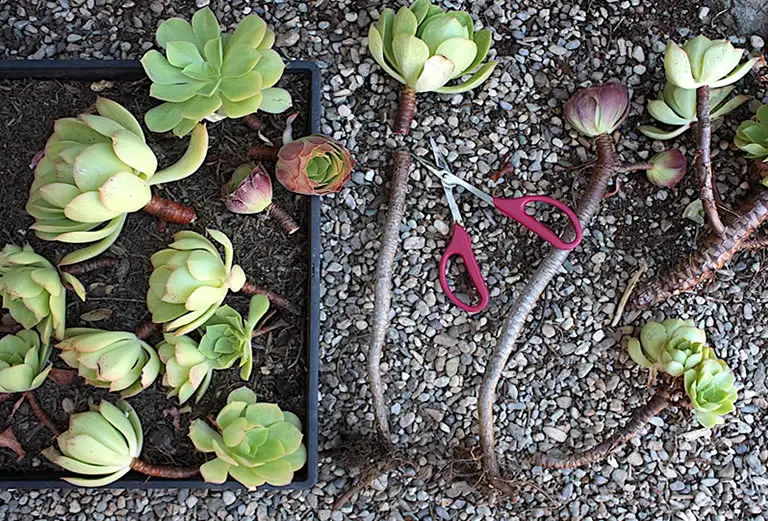
Aeoniums are bold and beautiful, and luckily for plant lovers, they’re also easy to propagate.
With their rosette-forming leaves and branching stems, Aeoniums can be multiplied by cuttings, offsets, or even seeds—though each method has its own timing and technique.
Unlike many succulents, Aeoniums grow during the cooler months and often enter a dormant phase during the heat of summer.
This makes understanding their seasonal rhythm essential when it comes to propagation.
Let’s walk through the best ways to expand your Aeonium collection—indoors or out.
Table of Contents
- When to Propagate Aeoniums
- Propagating from Stem Cuttings (Best and Most Common Method)
- Propagating Aeonium Offsets and Pups
- Propagating from Leaves (Not Ideal for Aeoniums)
- Propagating from Seed (Slow but Rewarding)
- Can Aeoniums Be Rooted in Water?
- Outdoor Aeonium Propagation
- Easiest Aeonium Varieties to Propagate
- Final Thoughts
When to Propagate Aeoniums
The ideal time to propagate Aeoniums is during their active growing season—typically fall through spring.
Avoid taking cuttings in the summer when the plant is dormant.
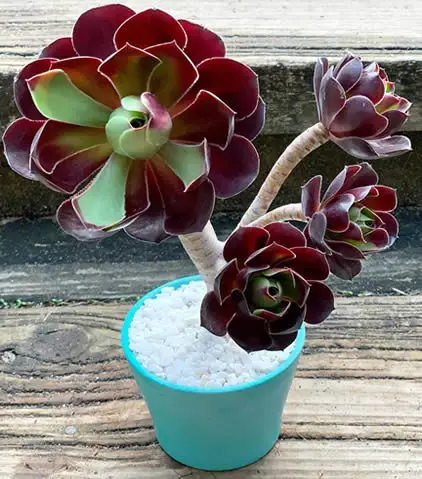
During dormancy, leaves may shrivel or drop, and rooting success is much lower.
If you live in a mild climate or keep your Aeonium indoors year-round, you can propagate whenever the plant shows signs of growth—but autumn and early spring are still the safest bets.
Propagating from Stem Cuttings (Best and Most Common Method)
Most Aeonium varieties propagate very well from stem cuttings.
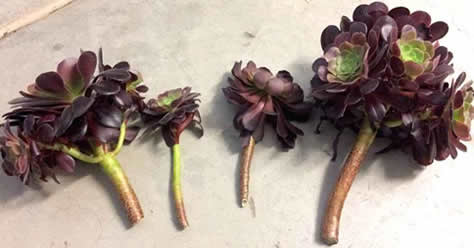
This method is fast, reliable, and works with both branching and single-stemmed types like Aeonium arboreum or Aeonium ‘Black Rose’.
-
Use clean, sharp scissors or pruning shears to cut a healthy stem with a full rosette.
-
Let the cutting sit in a dry, shaded area for 3–5 days to allow the cut end to callous.
-
Once dry, plant the cutting in well-draining succulent or cactus soil, inserting the stem about 1–2 inches deep.
-
Place in bright, indirect light and wait 5–7 days before watering for the first time.
-
Water sparingly until roots develop—usually within 2–3 weeks.
You can also root cuttings in perlite, sand, or pumice for extra aeration.
Propagating Aeonium Offsets and Pups
Some Aeonium varieties, like Aeonium haworthii and Aeonium ‘Kiwi’, produce small offshoots (pups) at the base or along the stem.
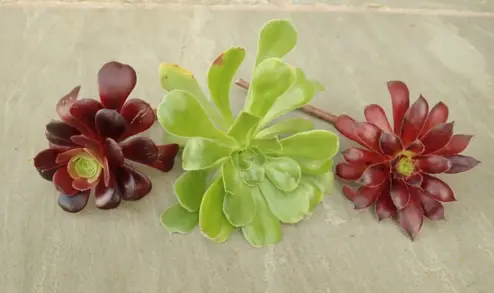
-
Gently remove the plant from its pot and brush off the soil to expose the roots.
-
Identify offsets with a few of their own roots attached.
-
Use your fingers or a sterile knife to separate the pup from the main stem.
-
Allow any fresh cuts to callous for 1–2 days before planting.
-
Pot the offset in dry succulent soil and wait several days before watering.
This method is ideal for rejuvenating a mature, overgrown plant and creating new ones at the same time.
Propagating from Leaves (Not Ideal for Aeoniums)
While many succulents can be propagated from single leaves, Aeoniums generally do not propagate well from leaf cuttings.
Their fleshy leaves are prone to drying out and rarely produce roots or rosettes.
Stick with stem cuttings or offsets for the best results.
Propagating from Seed (Slow but Rewarding)
If your Aeonium flowers (usually after several years), it may produce seeds—especially if pollination occurs.
Propagation from seed takes patience but can be rewarding for rare hybrids.
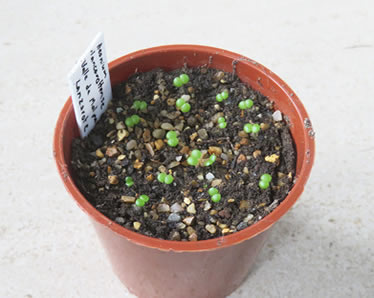
-
Scatter seeds on top of lightly moistened cactus mix or sandy soil.
-
Do not bury the seeds—just press gently into the surface.
-
Cover with a humidity dome or plastic wrap and place in bright, indirect light.
-
Keep the soil barely moist until germination, which can take 2–4 weeks or more.
-
Once seedlings are established, thin them out and repot into individual containers.
This method works best in warm, controlled environments and is ideal for collectors or growers seeking large batches of plants.
Can Aeoniums Be Rooted in Water?
Aeoniums are best propagated in soil, not water.
Their stems are prone to rot when left in water for extended periods.
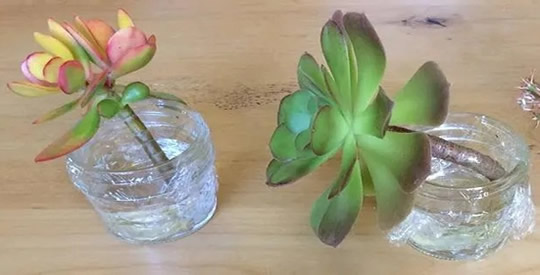
If you’re curious, short experiments with water rooting can be done in a very shallow container—but always keep the base above the waterline.
Bonus Tip: If you try water propagation, add one drop of a diluted succulent-safe fertilizer (such as 5-10-10 like this one or 2-7-7 like this one) to the water to lightly feed the cutting while it begins rooting.
For best results, return to soil once roots are visible.
Outdoor Aeonium Propagation
In USDA zones 9–11, you can propagate Aeoniums directly outdoors.
-
Take stem cuttings or divide offsets in fall or spring, when temperatures are mild.
-
Allow cuttings to callous in a shaded area, then plant directly into well-draining garden beds or raised containers.
-
Choose a spot with morning sun and afternoon shade, or filtered light if conditions are hot.
-
Avoid watering for the first few days, then water deeply but infrequently as roots form.
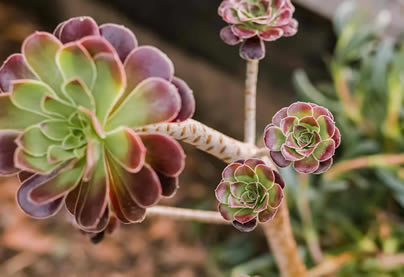
Aeoniums do well in outdoor rock gardens, succulent beds, and Mediterranean-style landscapes.
Just avoid planting before heavy rains or frost.
Easiest Aeonium Varieties to Propagate
Here are a few varieties that respond especially well to propagation by cuttings or offsets:
-
Aeonium ‘Mardi Gras’ – Colorful rosettes root easily and make bold new plants.
-
Aeonium ‘Kiwi’ – Fast-growing and pup-producing—great for division.
-
Aeonium ‘Black Rose’ (arboreum ‘Zwartkop’) – Reliable stem cuttings with dramatic results.
-
Aeonium arboreum – Grows upright and branches readily—perfect for cuttings.
-
Aeonium haworthii ‘Pinwheel’ – Offsets frequently and propagates quickly.
-
Aeonium ‘Sunburst’ – Responds well to pruning and cuttings with a bit more patience.
Final Thoughts
Aeonium propagation is simple, satisfying, and a great way to grow your collection without buying new plants.
With a clean cut, a little patience, and proper timing, you’ll soon have vibrant new rosettes ready to brighten your home or garden.
Whether you’re multiplying a beloved ‘Black Rose’ or creating colorful clusters of ‘Kiwi,’ every cutting brings the joy of new growth—and another reason to love this stunning genus.
Once you have your new plants rooted be sure to follow the guidelines outlined in our article Aeonium Care: How to Grow These Rosette-Forming Beauties Indoors and Out.
Thanks for reading! I'm Michael — houseplant fanatic and your Pinterest plant guide.
Follow me on Pinterest for fresh updates 🌿



